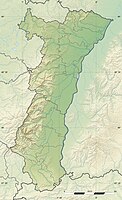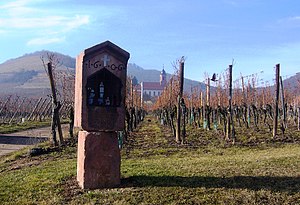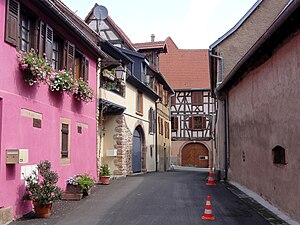 View over Saint-Hippolyte into the Rhine plain | ||
| Saint-Hippolyte (Haut-Rhin) | ||
| department | Haut-Rhin | |
|---|---|---|
| Residents | 1.004 (2018) | |
| height | 244 | |
| no value for height on Wikidata: | ||
| Tourist info | 33 (0)3 89 73 23 23 http://www.ribeauville-riquewihr.com | |
| no tourist info on Wikidata: | ||
| location | ||
| ||
.svg/200px-Blason_ville_fr_Saint-Hippolyte_(Haut-Rhin).svg.png)
Saint-Hippolyte (Eng. "Sankt Pilt") is a small winemaking village in FrenchAlsace and member of the association of Pays de Ribeauvillé and Riquewihr. The place is in the 3rd section of the Alsatian wine route (Terre et Vins au Pays de Colmar). The village is in the immediate vicinity too Rodern, with which it is also the vineyard Alsace Grand Cru Gloeckelberg Splits.
Saint-Hippolyte is one Ville fleurie, a "flower-adorned city" and carries im Concours des villes et villages fleuris ("Competition of cities and towns decorated with flowers") 2 out of 4 roses.
background
Something about the story
The Romans founded a place called on the site of today's place Andandolvillary and in addition to various types of vegetables and fruits, they also introduced wine.
Saint Hippolytus of Rome is the namesake of the place. His martyrdom is depicted in the town's coat of arms; his relics are kept at the altar of the parish church. One of the most influential figures of the second half of the 8th century, the saint, was born here Fulrad (~ 710-784), Abbot of Saint-Denis near Paris, who also founded the monastery here.
In the 11th century, the village came under the protection of the Dukes of Lorraine, where it was sheltered for almost six centuries. The Lorraine castle, mentioned in 1515, is now a hotel.
In 1316 the was at the foot of the castle Haut-Koenigsbourg The town that was built around the monastery is surrounded by a wall that still exists today, but is almost completely built over by houses. This circumstance creates a city (core) picture of densely packed houses, the ground floor of which consists of masonry with raised half-timbering and underground wine cellars or those on the ground floor, while the living rooms are on the upper floors. The expansion of the place outside the city walls took place in the 19th century. The only two city gates and five watchtowers, which were almost completely destroyed from 1862 to 1864, are no longer preserved. The tower on the south corner of the old town and the floor plan of a tower in the northeast have been preserved.
The Thirty Years' War did not spare this place, nor did the Peasant Wars.
Viticulture, introduced by the Dukes of Lorraine with the Burgundian Pinot Noir grape, made the place famous with a wine with the Designation of Origin Rouge de Saint-Hippolyte. Johann Fischart, the early New High German writer and poet from Strasbourg, praised wine with these words as early as the 16th century Red from Santa's pilt, oh how mild!.
The crest
Blazon: (Source: Book of arms of the municipalities in Haut-Rhin from 1981)
- d'azur à Saint Hippolyte de carnation, la tête auréolée d'or, les mains croisées sur son corps et les pieds attachés à une corde de sable tirée par un cheval contourné d'argent monté par un bourreau de carnation, vêtu de gueules, tenant de sa dextre un fouet aussi de sable, le tout soutenu d'un écusson d'or chargé d'une bande de gueules surchargée de trois alérions d'argent, sommé d'une couronne de marquis aussi d'or
- Prose translation (not exactly heraldic): "On blue the flesh-colored St. Hippolyte with a golden halo, hands crossed over the chest and feet tied with a black rope, pulled by a silver horse going to the left, on which a flesh-colored executioner sits, dressed in red, holding a black riding crop in his right hand, everything on a golden shield, with a sloping beam with three mutilated eagles in silver, crowned by the golden marquis crown ". The small gold-colored coat of arms with the crossbar and the three headless lions is the coat of arms of Lorraine. Ferry I (1143-1206) was the first King of Lorraine to wear this coat of arms. For marquis there is no German equivalent, especially since the term also had different meanings in French depending on the epoch.
getting there
By plane
The nearest commercial airports are the Strasbourg airport![]() (IATA: SXB), 55 km, and EuroAirport Basel-Mulhouse-Freiburg
(IATA: SXB), 55 km, and EuroAirport Basel-Mulhouse-Freiburg![]() (IATA: BSL, MLH, EAP), 81 km.
(IATA: BSL, MLH, EAP), 81 km.
The Colmar-Houssen airfield (16 km away) allows the landing of small private planes.
By train
The place does not have a train station. The nearest train station with a TGV stop is in Sélestat.
By bus
A 109 bus connects Colmar every 4 hours. There is no bus connection to Sélestat, you have to go to Colmar and then take the train there.
In the street
The journey takes place by car
- from north and south over the
 Alsacienne auto route,
Alsacienne auto route,  18 Saint-Hippolyte, then about that D 1bis directly in the center of the village.
18 Saint-Hippolyte, then about that D 1bis directly in the center of the village. - from the west from inland (Sainte-Croix-aux-Mines) about the N 59 to Lièpvre and D 481 to the department border, then on the one that is now called D 42 and the D 1bis to Saint-Hippolyte.
- from the east: The next Rhine crossings to Germany are at Breisach (41 km) and Marckolsheim (25 km)
mobility
&groups=Maske,Track,Aktivitaet,Anderes,Anreise,Ausgehen,Aussicht,Besiedelt,Fehler,Gebiet,Kaufen,Kueche,Sehenswert,Unterkunft,aquamarinblau,cosmos,gold,hellgruen,orange,pflaumenblau,rot,silber,violett)
Like many others in the region, the place is surrounded by vineyards. The location is divided into three parts: There is the old town, in which the sights described can be found, and two newer residential areas in the south-east and south-west of the city center. The main road Route du Vin has a gradient of about 20 m to about 300 m from the church to the southeast end of the old town.
Tourist Attractions
Streets and structures (excluding the church)

A possible walk through the town can begin at the town hall: (The numbers in brackets indicate the picture number in the adjacent gallery)
- 1 Mairie - At the town hall a large stone slab is worth seeing, which shows the coat of arms of Duke Karl III. von Lorraine and the bailiff Ulrich von Wittingen show. It comes from the former castle of the dukes in Saint-Hippolyte. (5, 6)
- On the main facade you can see a small sandstone balcony, which probably dates from 1782. The tower with its bronze bell from 1683 has been preserved from the earlier Renaissance building.
- 2 3 place de l'Hôtel de Ville - 3 place de l'Hôtel de Ville: The carved wooden corner post on the first floor of the framework with the baker's guild mark, which can also be found above the front door of the house, where the year 1586 can be seen, is remarkable. (7, 8)
- In the same place is the fountain mentioned in 1555 with traces of earlier coats of arms. On the side next to the cellar entrance of the house is a shelf made of sandstone and wrought iron at the edge of the fountain, which the winemakers used to put down their grape-filled hottops, which weighed more than 60 kg when filled. (9)
- 3 3 rue de la Montée - 3 rue de la Montée: this building has several characteristics of a 17th century winemaker's house: carved corner posts, a bay window (1688) with beautifully sculpted bas-reliefs in the window parapets, a gable (1683). On the wall in the gate entrance you can discover a stone slab with the upturned scallop shell as a sign that the place is on the Way of St. James and the Lorraine cross. (10, 11)
- 4 3 rue Saint-Hippolyte - 3 rue Saint-Hippolyte: very beautiful carved corner post of the house from 1684 and a regular framework with geometric patterns in the gable wall. The year 1786 is engraved in the lintel. (12)
- 5 College - The former castle of the Dukes of Lorraine has been a hotel and seminar center since 2008. The castle was first mentioned in 1515. It was built by the dukes to secure the Alsatian Rhine plain, for recreation and as a hunting residence. It used to be part of the city fortifications. In 1633 it suffered damage in the Thirty Years' War, which was only removed with a new building in 1718 by Duke Leopold of Lorraine. After various changes of ownership, it came to Father in 1825 Chaminade from Bordeaux, the founder of the "Society of Mary" (Marianists). The religious college established by the Marianists became a nursing home for their older religious brothers in 1986 and in 2008 it became today's hotel, where religious brothers still spend their retirement. (15, 16)
- 6 13 rue du Collège - 13 rue du Collège: note the pretty little fountain on the corner of the house and above it the nicely carved corner pillar. From here you also have a nice view of the castle Haut-Koenigsbourg.
- 7 Ancien fossé - In the former ditch in front of the medieval city wall, a canalised stream now runs into a small reservoir that the residents use Wesch because the horse owners used to wash their horses here. (17, 18)
- 8 Fontaine - The fountain on Rue des Cigognes is crowned by a Gallic rooster that was once painted white, blue and red.
- 9 Ancien couvent Saint-Fulrade - The former monastery of Saint-Fulrade was founded by Abbot Fulrad around the year 774. It later became a manor and then a Dinghof.
- 10 Notre-Dame-de-Douleurs - The Notre-Dame-de-Douleurs chapel was built in 1888, the benefactor Abbot Simler was a native of the town and a superior general of the Marianists.
- 11 1 place de l'Hôtel de Ville - The corner house opposite the church shows a statue of the Virgin Mary with child in a niche in the corner of the house. To the left of it is a beautiful renaissance gate dated 1768. (21)
- 12 64 route du Vin - 64 route du Vin: on the corner of the house, note the year 1601 and the guild mark of the tailor. Richly carved corner posts on the upper floor, today no longer on the corners due to a house extension.
- 13 59 route du Vin - 59 route du Vin: The former hospital was built in the 16th century, of which there is still a gable towered over by a tower with the coat of arms of the Duke of Lorraine. It has not served as a hospital since 1861 due to hygienic problems.
Saint-Hippolyte church

The numbers in brackets indicate the position of the corresponding picture in the gallery "Pictures of the Church of Saint-Hippolyte".
- 14 Église Saint-Hippolyte - The Saint-Hippolyte church: around 800, Abbot Fulrad A church has already been built here, but it burned down and was renovated in the 14th century. In the course of an expansion, some adjacent houses were demolished in 1821. (1)
- The choir with a five-sided apse has high lancet arches to accommodate the church windows, which were renewed in 1947 after they were completely destroyed, and which tell the story of St. Hippolytus. (2, 5)
- The main altar is made of marble, stick and gilded wood and dates from the 18th century. (3)
- In the choir there is also the reliquary of St. Hippolytus made of gilded wood from 1766. (4)
- The paintings in the choir show scenes from the life of Abbot Fulrad (6) and the Ascension of St. Hippolytus.
- The oak choir stalls, reserved for clergymen only, date from the 18th century. (7)
- The pillars in the nave are from different building eras: The pillars near the choir and composed of 4 pillars are from the 14th century and are therefore the oldest; in the middle and at the back there are round (17th century) and octagonal (19th century) pillars. Note also the magnificent pulpit. (8th)
- The wall paintings above the pillars depict the Adoration of the Magi and the Holy Communion. (9, 10)
- The wood-paneled ceiling shows the four Doctors of the Western Church: Ambrose of Milan, Augustine of Hippo, Gregory the Great and Hieronimus (from Stridon). In the middle of it you can see the blessing Christ with the inscription EGO SUM VIA, ET VERITAS, ET VITA ("I am the way, the truth and the life"). (11)
- A specialty is the Silbermann organ, a masterpiece of the organ builder Johann Andreas Silbermannwho made them 1736-1738 for the Marbach Abbey built. Bought from him and installed in the church of Saint-Hippolyte in 1790, it is one of the few Silbermann organs preserved in Alsace. (12)
activities
The place is ideal as a starting point for trips to Strasbourg, Sélestat, Haut-Koenigsbourg and in the other places of the Community association.
Several hiking trails are signposted.
shop
There is little or no shopping opportunity for everyday goods, everything is available in the larger neighboring towns, mainly in the nearby one Sélestat.
kitchen
There are many in a typical Alsatian wine town like this one Winstubswhich offer small, regional dishes in addition to wine. You can also find restaurants, but also in the neighboring communities.
Here is a selection of local restaurants:
- 1 Le Hupsa Pfannala restaurant, 59 route du Vin, 68590 Saint-Hippolyte. Tel.: 33 (0)3 89 73 03 65. The house also has guest rooms and other accommodation options, see website.
- 2 Restaurant au Rouge de Saint-Hippolyte, 36 route du Vin, 68590 Saint-Hippolyte. Tel.: 33 (0)3 89 73 05 58. According to its own information, a **** restaurant.
nightlife
accommodation
- 1 Hotel Val-Vignes, 23 Chemin du Wall, 68590 Saint-Hippolyte. *** Hotel and seminar center.
- 2 Hostellerie Munsch aux Ducs de Lorraine, 16 route du Vin, 68590 Saint-Hippolyte. Tel.: 33 (0)3 89 73 00 09, Email: [email protected]. Small hotel, wine sales.Price: Room prices from 50 to 70 €, plus 7 € breakfast in the room.
security
health
Emergency numbers
Please refer Emergency numbers in France
Practical advice
trips
The place is an ideal starting point in the other very beautiful villages of the community association, in the Vosges, to the nearby castle ruins Haut-Koenigsbourg and to Colmar.
literature
Individual references and sources
- Tourist information brochure (also in German)
Web links
- http://www.saint-hippolyte-alsace.fr/ - Official website of Saint-Hippolyte



































